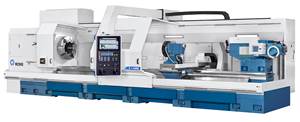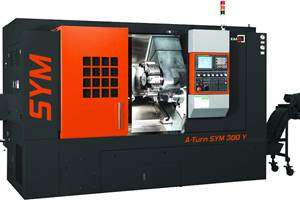Five Fold Growth Forged With CNC Turning Centers
This shop saw its production volume mushroom after it began making tooling for the hot forging of automotive and non-automotive engine valves.
Atomic City Tool (ACT), Inc., saw its production volume mushroom after it began making tooling for the hot forging of automotive and non-automotive engine valves. Powered by five Cincinnati Machine horizontal CNC turning centers, ACT has seen a five-fold increase in volume in just over five years of making the valve tooling. So reports Bob Smith, who founded the Oak Ridge, Tennessee company 30 years ago.
The Milacron machines -- three Talons and two Avengers -- allow ACT to create forge tooling that produces virtually perfect valve geometries and exceptional surface finishes.
ACT turns out 8,000 to 9,000 pieces of disposable/consumable forge tooling each month to meet the production and inventory requirements of two valve manufacturing plants, which together produce over 50 million valves per year. The tools are made from H-10, H-11, H-13, and H-19 steels to many different valve sizes and configurations. All tools are heat-treated, and most are nitrided as well.
The goal of the valve manufacturer is to shape valves to finish form solely through precision forging says Mr. Smith. This optimizes physical integrity of the valve while minimizing processing operations and part costs. However, it places critical demands on tooling.
To precision-shape the valves, ACT creates extrusions and coining tools -- essentially forging dies. A valve slug is heated, then pressed into a bore in the extrusion tool to create the valve geometry, a round stem flaring out to a broad base. A coining die then shapes the underside geometry of the valve base.
"The tools used in these processes must forge virtually a perfect valve with a forge-finished underhead," says Mr. Smith. The Milacron turning centers not only "nail" the dimensional geometry -- ID, OD, and taper blending -- but also achieve a surface finish below 0.8 Ra.
The accuracy and finishes that ACT achieves on the Milacron turning centers have dramatically improved tool life for the valve plants, and eliminated costly finishing operations. "The machines sharply reduce cost per valve, which is the bottom line," he says.
Tooling ODs range from 0.5 inch to 3.25 inches and lengths from one inch to 9.5 inches. ID stem bores can be as small as 0.2664 inch.
The Talon and Avenger HTCs also hard-turn some finish dimensions after heat-treating and nitriding, all to less than 0.0005-inch tolerance. "With the tools at the top end of the Rockwell C hardness scale, this is real test of turning center's rigidity and damping ability," he says, "but repeat-abilities have been excellent."
Atomic City Tool is a complete tool and die shop, specializing in precision tools, gages, and fixtures for the hermetic motor, synthetic fiber, bearing, stamping, and engine/automotive industries. It serves customers from Pennsylvania to Florida and from the Atlantic Coast to Arkansas. The 35-employee shop is known throughout the region for its creative machining and for the close tolerances they hold.
Five years ago, ACT won a contract on competitive bidding to produce valve tooling. The tooling was an immediate hit. Volume zoomed, quickly soaking up the capacity of the plant's existing turning equipment. Faced with a critical need for additional capacity, Mr. Smith and his staff focused on finding proven, versatile turning centers that could meet growing quantity and quality that the customers demanded.
After evaluating CNC turning centers from many major manufacturers, they selected three Talon 208 turning centers from Milacron. The deciding factors were rigidity, horsepower and chucking capacity, says Mr. Smith. He was particularly impressed at its accuracy on the high-hardness materials.
About a year and a half later, again looking to expand their capacity, ACT decided to look at turning centers offering a sub-spindle option. "We realized that the right sub-spindle machine would offer tremendous efficiency on some of our part families," says Mr. Smith.
ACT evaluated nearly every turning center offering a sub-spindle. "All except the Avenger seemed to be designed for light duty only -- little better than a light face cut," says Mr. Smith. The Avenger has a much more powerful sub-spindle -- 8-hp, compared to about 3 hp for other machines.
The Avengers have significantly cut the cycle time on every family of tools run on them. Sub-spindle capability lets ACT handle much of its work with fewer setups and processing operations. "We're producing many tools in a single operation that used to require two," says Mr. Smith. "Plus, the Avenger's horsepower and rigidity let us take deeper cuts in hard steels for the valve tooling."
The shop runs its Talon and Avenger CNC turning centers 60 hours weekly 10-hour shifts, 6 days a week with customer demand steadily rising. Valve tooling has grown to the point where it is now handled as a separate business for the company, says Mr. Smith.
"Over the next five years we'll likely add three to five additional turning centers and replace our non-Milacron CNC lathes and the new machines will be Talons or Avengers. Buying the Milacron turning centers has proven to be one of my best business decisions. I've recommended them to numerous other people in the metalworking business." MMS
Related Content
Romi Launches Flatbed Lathe for Machining Large Parts
The C 1100H is a heavy-duty flatbed lathe built with a monoblock cast iron bed that absorbs machining efforts and vibration, making it highly rigid, stable and accurate.
Read MoreKaast Machine Tools Updates Dual-Spindle Lathe
The A-Turn SYMCNC Dual-Spindle Lathe is now available in four different swing lengths, including 22.5", 24", 26.75" or 36".
Read MoreInverting Turning and Five-Axis Milling at Famar
Automation is only the tip of the iceberg for Famar, which also provides multitasking options for its vertical lathes and horizontal five-axis machine tools.
Read MoreQuick-Change Tool Heads Reduce Setup on Swiss-Type Turning Centers
This new quick-change tooling system enables shops to get more production from their Swiss turning centers through reduced tool setup time and matches the performance of a solid tool.
Read MoreRead Next
Encountering Surface Finishes in the Everyday World
Surface measurement is becoming increasingly important to ensure proper performance of a manufactured product. Advanced surface measurement tools are not only beneficial in the manufacturing industry but also have unconventional applications.
Read MoreObscure CNC Features That Can Help (or Hurt) You
You cannot begin to take advantage of an available feature if you do not know it exists. Conversely, you will not know how to avoid CNC features that may be detrimental to your process.
Read MoreA History of Precision: The Invention and Evolution of Swiss-Style Machining
In the late 1800s, a new technology — Swiss-type machines — emerged to serve Switzerland’s growing watchmaking industry. Today, Swiss-machined parts are ubiquitous, and there’s a good reason for that: No other machining technology can produce tiny, complex components more efficiently or at higher quality.
Read More









.jpg;maxWidth=300;quality=90)



 – Medium Rectangle (1).png;maxWidth=300;quality=90)











